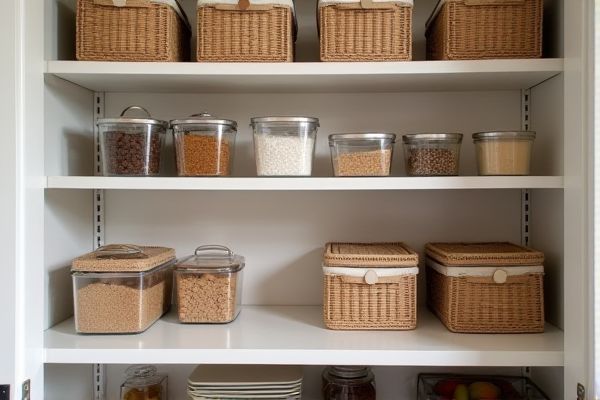
Choosing between a basket shelf and a cubby shelf for your pantry influences organization and accessibility; basket shelves provide flexible storage for loose or bulky items while cubby shelves offer compartmentalized space ideal for categorizing goods. Explore the full article to discover which option best suits your pantry needs and enhances your kitchen's functionality.
Table of Comparison
| Feature | Basket Shelf | Cubby Shelf |
|---|---|---|
| Design | Open wire or woven baskets | Compartmentalized square or rectangular units |
| Storage Type | Flexible, holds loose items and produce | Structured, ideal for organized item placement |
| Visibility | Easy to see contents | Contents partially hidden within cubbies |
| Access | Quick, pull-out baskets | Items remain fixed in compartments |
| Airflow | Good ventilation, reduces moisture | Limited airflow inside cubbies |
| Customization | Often adjustable basket sizes | Fixed cubby dimensions |
| Best Use | Produce, snacks, flexible pantry storage | Jars, canned goods, neatly organized pantry items |
| Cleaning | Easy to remove and clean baskets | More difficult to clean cubby compartments |
Introduction to Pantry Organization
Basket shelves in pantries offer flexible storage with breathable containers ideal for produce and snacks, enhancing visibility and accessibility. Cubby shelves provide segmented compartments that help categorize items such as canned goods, spices, and smaller pantry staples, supporting systematic organization. Choosing between basket and cubby shelves depends on the need for ventilation and ease of access versus precise item separation for optimized pantry layout.
What Is a Basket Shelf?
A basket shelf in a pantry consists of wire or woven baskets slid into a frame, allowing for easy visibility and airflow around stored items. It offers flexible storage for produce, snacks, and bulk goods, making it ideal for organizing irregularly shaped or perishable items. Your pantry benefits from improved accessibility and ventilation compared to traditional solid cubby shelves.
What Is a Cubby Shelf?
A cubby shelf in a pantry consists of evenly divided compartments designed to store various items such as canned goods, snacks, or small kitchen tools, offering organized and easily accessible storage. Unlike basket shelves, which often use pull-out baskets or bins for flexible storage, cubby shelves provide designated spaces that help maintain order and visibility of your pantry items. You can maximize pantry space by choosing cubby shelves for sorting different food categories efficiently.
Space Efficiency: Basket vs Cubby Shelves
Basket shelves maximize space efficiency by allowing flexible storage of irregularly shaped items, making them ideal for pantries with varied product sizes. Cubby shelves provide structured compartments that help organize pantry items in neat sections but may sacrifice some storage capacity due to fixed space divisions. Your choice depends on whether you prioritize adaptable storage or systematic organization within your pantry.
Accessibility and Ease of Use
Basket shelves offer easy access with their pull-out design, allowing you to reach pantry items without bending or moving other containers. Cubby shelves provide organized compartments but may require more effort to access items stored in deeper or higher sections. Your choice depends on whether quick, effortless retrieval or compartmentalized organization is more important for your pantry needs.
Versatility for Different Pantry Items
Basket shelves offer flexible storage for bulky or irregularly shaped pantry items, allowing easy access and ventilation for fresh produce. Cubby shelves provide organized compartments ideal for canned goods, spices, and smaller containers, maximizing vertical space and item visibility. Choosing between basket and cubby shelves depends on the specific pantry items needing storage and preferred organization style.
Aesthetic Considerations and Style
Basket shelves offer a rustic, textured appeal that enhances farmhouse and casual kitchen styles with their woven materials and organic shapes. Cubby shelves provide a clean, modern look with uniform compartments that suit minimalist and contemporary pantry designs. Your choice depends on whether you prefer the warm, tactile feel of baskets or the sleek, organized appearance of cubbies to complement your kitchen's aesthetic.
Cleaning and Maintenance Comparison
Basket shelves in pantries typically require more frequent cleaning due to open slats that collect dust and food debris, while cubby shelves with enclosed compartments tend to keep items cleaner and reduce dust accumulation. You can easily wipe down cubby shelves and maintain a tidy appearance, whereas basket shelves may need occasional removal and thorough washing to prevent residue buildup. In terms of maintenance, cubby shelves offer a more straightforward clean-up process, making them ideal for busy households seeking efficient pantry organization.
Cost Analysis and Budget
Basket shelves generally cost less upfront than cubby shelves due to simpler materials and construction, making them ideal for budget-conscious pantry organization. Cubby shelves, while initially more expensive, offer long-term value through enhanced durability and customizable storage options, potentially reducing the need for replacement or additional accessories. Budget planning should factor in both initial investment and maintenance costs, with basket shelves suited for short-term solutions and cubby shelves favorable for long-term pantry optimization.
Which Shelf Type Suits Your Pantry Needs?
Basket shelves offer flexible storage with easy access and visibility, making them ideal for pantry items that vary in size and shape. Cubby shelves provide organized, compartmentalized space perfect for categorizing and neatly storing dry goods like canned foods and spices. Your choice depends on whether you prioritize adaptability and quick reach, favoring basket shelves, or orderliness and dedicated spots, favoring cubby shelves.
 homyna.com
homyna.com